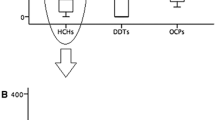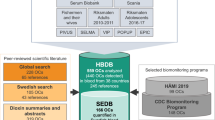Abstract
Methylene chloride (dichloromethane) is widely used as a solvent for stripping of paint, as industrial cleaning agent, for coating of pills in the pharmaceutical industry, and in the decaffeination of coffee. There is “sufficient evidence for the carcinogenicity” of methylene chloride in animals and “inadequate evidence for its carcinogenity in humans”, according to IARC (IARC 1987; CEC 1990).
Access this chapter
Tax calculation will be finalised at checkout
Purchases are for personal use only
Preview
Unable to display preview. Download preview PDF.
Similar content being viewed by others
References
CEC, Commission of the European Communities, Industrial Health Service (1990) The toxicology of chemicals: 1 Carcinogenity 2:67–74
ECETOC (1989) Methylene chloride (dichloromethane): An overview of experimental work investigating species, differences in carcinogenicity and their relevance to man. Technical Report No. 34
Hallier E, Deutschmann S, Reichel C, Bolt HM, Peter H (1990) A comparative investigation of the metabolism of methyl bromide and methyl iodide in human erythrocytes. Intern Arch Occup Environ Health 62:221–225
IARC, International Agency for Research on Cancer (1987) IARC Monographs on the evaluation of carcinogenic risks to humans, Suppl. 7, Overall evaluations of carcinogenicity: an updating of IARC Monographs. Volumes 1 to 42 Lyon, 194–195
Lowry OH, Rosenbrough NJ, Farr AL, Randall RJ (1951) Protein measurement with the Folin phenol reagent. J Biol Chem 193: 265–275
Ottenwälder H, Jäger R, Thier R, Bolt HM (1989) Influence of cytochrome P-450 inhibitors on the inhalative uptake of methyl chloride and methylene chloride in male B6C3F1 mice. Arch Toxicol Suppl 13:258–261
Peter H, Deutschmann S, Reichel C, Hallier E (1989) Metabolism of methyl chloride by human erythrocytes. Arch Toxicol 63:351–355
Strange RC, Johnson PH, Lawton A (1982) Studies on the variability of glutathione Stransferase from human erythrocytes. Clin Chim Acta 120:251–260
Author information
Authors and Affiliations
Editor information
Editors and Affiliations
Rights and permissions
Copyright information
© 1991 Springer-Verlag Berlin Heidelberg
About this paper
Cite this paper
Thier, R. et al. (1991). Distribution of Methylene Chloride in Human Blood. In: Chambers, P.L., Chambers, C.M., Wiezorek, W.D., Golbs, S. (eds) Recent Developments in Toxicology: Trends, Methods and Problems. Archives of Toxicology, vol 14. Springer, Berlin, Heidelberg. https://doi.org/10.1007/978-3-642-74936-0_53
Download citation
DOI: https://doi.org/10.1007/978-3-642-74936-0_53
Publisher Name: Springer, Berlin, Heidelberg
Print ISBN: 978-3-540-51422-0
Online ISBN: 978-3-642-74936-0
eBook Packages: Springer Book Archive




